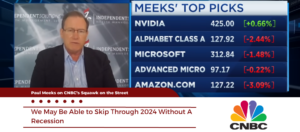Hold the phone! Tech ain’t winning. In 2021’s first quarter, the tech-heavy NASDAQ Composite was still +2.8%, or +11.6% annualized, but the broader S&P 500 added +5.8% and the Russell 2000 small-cap stocks index jumped +12.4%. These returns exclude dividends.
So, what gives? For the most part, tech fundamentals are strong and have strengthened during COVID. Of course, some of these companies will suffer a pandemic hangover after we’re all vaccinated because we’ll go back to the analog world after living in a digital one for a year; and tech drives the digital paradigm. I think that you may be surprised at how sticky some of these personal and professional changes will be even after we shake COVID. I’m delving into my tech stocks to try to differentiate between which firms will hold our attention and, more important, keep our dollars once we return to normalcy. Don’t give up on this sector yet because some of these technologies and their firms are here to stay so their stocks still may be cheap for the long term even after skyrocketing in 2020.
I think that the catalyst for the return to tech has little to do with how much software or how many semiconductors they sell but more to do with the path of US interest rates. I am a Professor of Practice at the Tommy and Victoria Baker School of Business at The Citadel in Charleston, SC. I teach my students to follow America’s “risk-free” rate, which is the yield on the 10-year Treasury note. Currently, it’s 1.7%. While historically low, the yield was 0.5% last August.
What does this have to do with tech stock valuations? For better or worse, a lot. All assets are valued by discounting future cash flows that investors are to receive to the present. The discount factor is the current interest rate, Therefore, even if the numerator in the formula, cash flow, doesn’t change, the resulting valuation drops, often quickly and significantly, as the rate in the denominator rises; and, folks, expensive tech stocks are THE most sensitive to rising rates, so their shares take the biggest beatings in this environment. Here’s the tell when it’s safe to go back in the tech water: Let the yield on the 10-year Treasury note plateau for at least a few weeks. You can find the yield on any financial news aggregator website including https://www.cnbc.com/markets/.
I’m tech 24/7/365, so, when the sector is out of favor, I often must buy the dogs with the fewest fleas. I’m now hiding in semiconductor stocks, but I actually think that I can make money investing in this industry. Why? First, these stocks were not grossly overvalued before tech started to underperform the market. Second, we’re in a global semiconductor shortage. Case in point: Consulting firm AlixPartners predicts that this chip shortage will cost the worldwide automobile industry $61 billion in lost sales in 2021. Ford just announced that it has closed six North American plants because they don’t have critical semiconductors. President Biden has even earmarked $50 billion in his infrastructure bill to add US semiconductor capacity. While chip scarcity is bad for customers, it’s great for semiconductor vendor pricing. Third, believe it or not, chip demand is to increase even more because ramping 5G wireless, artificial intelligence (AI), and autonomous driving are semiconductor hogs. In the chip industry, I own these 15 stocks in alphabetical order by ticker symbol:
- Applied Materials (AMAT)
- Ambarella (AMBA)
- Broadcom (AVGO)
- Cadence Design Systems (CDNS)
- Kulicke and Soffa (KLIC)
- Microchip (MCHP)
- Micron Tech (MU)
- NVIDIA (NVDA)
- NXP Semi (NXPI)
- QUALCOMM (QCOM)
- Qorvo (QRVO)
- Synopsys (SNPS)
- Skyworks (SWKS)
- Synaptics (SYNA)
- Taiwan Semi (TSM)
I’ll highlight my favorite, MU ($92.41). It’s a leader in memory chips both DRAM (Dynamic Random-Access Memory) and NAND flash. The former accounts for about 70% of the company’s sales. The latter contributes approximately 30%. The latest gadgets including smartphones demand more and more memory. MU is a DRAM oligopolist and their business cycle is ramping. The company earned $2.83 per share in fiscal 2020 (ended August). One Wall Street analyst has published a forecast for EPS to be $21 in five years. I think that that’s nuts, but you see the trend. Let’s see if MU can deliver the mail. I’m betting on it.





